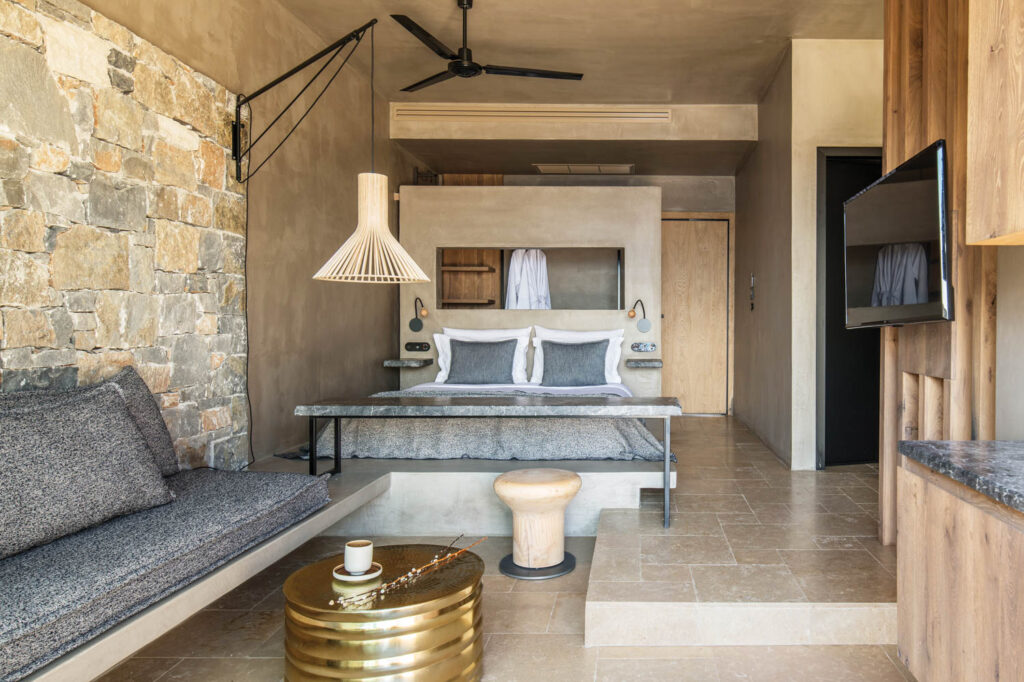Nearly 4,000 years ago, on the Greek island of Crete, the Minoans, one of the few societies believed to have been matriarchal, birthed the first advanced civilization in Europe. It’s an achievement worth mulling over when savoring a glass of kotsifali, a red wine made from grapes native to the island, and looking out onto the Sea of Crete from the terrace of the bar at Acro Suites, a new wellness resort near the fishing village of Agia Pelagia. While the stunning property, conceived by two local sisters, Danae and Konstantina Orfanaki, may not represent the birth of a more advanced civilization, it surely heralds the dawn of a more enlightened and environmentally responsible approach to Aegean hospitality design.
The siblings, cofounders of the firm Afoi Orfanaki, have hospitality in their blood. They grew up at their parent’s nearby resort, learning the business while developing ideas about what a next-gen Cretan destination should be. After studying hospitality management and interning at top hotels abroad, the two young women returned home and set about renovating a few sections of the family property to show off their novel ideas. Impressed, their father gave them free reign at a new hotel venture he was developing on 20 clifftop acres above Mononafatis Bay.
Acro Suites Reflects the Beauty of Crete
Orfanaki Sr. and local architect Stavros Peppas, who had already begun the project, envisioned “a small Santorini with all-white buildings,” Danae says. “But that’s not what we had in mind. Our desire was to promote the site’s raw, natural beauty with a design that was as organic as we could make it.” This new vision required modifying the partly built resort where possible—a task the sisters assigned Alexandros Kolovos, copartner, with civil engineer Vassiliki Exarchou, of Athens-based CMH Architecture, a firm known for its respect for nature. Sensitive to both the privileged setting and the island’s ecology, the completed hotel comprises a stepped chain of one- and two-story structures—45 suites, four villas, a wellness center, restaurant, and the terraced bar—perched along the cliff. Constructed of local timber and stone, some of it excavated on-site, the earth-toned complex blends in with its rugged surroundings. Although rustic in appearance, the property is powered by a geothermal system and a photovoltaic park, and guest facilities incorporate smart technologies to reduce electricity consumption wherever possible.

How a Cliffside Locale Lends Itself to Sustainable Design
It took about four years to develop the final form of Acro Suites, the name being a play on the Greek akros, meaning on the edge, a nod to the way the hotel hugs the bluff, affording spectacular views of the jagged rocks and roiling surf below. “Standing on those cliffs, I felt like a seagull nesting on the rocky slope,” Kolovos says. “The views from the rooms were to give that exact same feeling.” Along with those panoramic vistas, each suite and villa boast an extended terrace and private saltwater pool. The suites encompass four typologies—Loft, Wave, Gaia, and Cave—the most remarkable being the last, which are carved out of the cliff face, their craggy open mouths framing the splendid seascape. Floor-to-ceiling glass fronts let light into the grottolike spaces, the walls a mix of exposed and plaster-covered living rock face, the furniture and millwork rendered in local timber, stone, and marble from ancient Phaistos. Being subterranean naturally modulates these suites’ interior temperature, reducing the need for heating or air-conditioning. “If the resort layout hadn’t already been established, we would have made the whole thing underground,” Danae admits. “But Alexandros topped the buildings with arches and domes to simulate the landscape.”
When Greece went into COVID lockdown, Kolovos had already determined the accommodations’ floor plans but not yet their decor. With travel to the island impossible, the two sisters took on the challenge themselves. In addition to collaborating with Crete’s gifted artisans and craftspeople on many of the furnishings, they also selected a scattering of international designer pieces and fixtures that were in keeping with the architect’s pared-down wabi-sabi aesthetic. While the room typologies are distinct, they all share one thing in common: textiles made locally from organic materials, with raw-silk bedcovers adding a touch of luxury.
Konstantina, a former gymnast who studies fitness with a passion, guided the development of Acro’s wellness component, playing on the concepts of harmony and balance, ancient ritual, and the union of earth, sea, sky, and self. She and Danae collaborated with Athens-based Utopia Hotel Design on the bathhouse that, along with the fitness facilities, constitutes the resort’s wellness center. Based on a traditional oval hammam, the bathhouse is fashioned from the same natural materials as the rest of the hotel but makes dramatic use of filtered natural light from an atrium to envelope the curvaceous whirlpool tubs and marble hot baths in an atmosphere that’s as sensuous as it is timeless and serene. The fitness amenities, which are housed in a long barrel-vault pavilion made of timber and bamboo, feature a yoga shala that looks out to the limitless blue horizon.

The Orfanaki sisters are already at work on a new ecologically minded Cretan destination. “It’s impossible to make a resort that is 100 percent sustainable, but we want the next one to take it to the max, while still being luxurious,” Danae says, before adding, “It’s going to take some years.” Until then, for planet-loving sybarites, there is Acro Suites.
An Inside Look at Acro Suites in Crete







